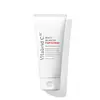Vitabrid C12 Daily-C Foam Cleanser Versus Aveeno Calm + Restore Nourishing Oat Cleanser For Sensitive Skin
What's inside
What's inside
 Key Ingredients
Key Ingredients

 Benefits
Benefits

 Concerns
Concerns

No concerns
 Ingredients Side-by-side
Ingredients Side-by-side

Propanediol
SolventWater
Skin ConditioningButylene Glycol
HumectantSodium Cocoyl Glycinate
CleansingSodium Cocoyl Isethionate
CleansingGlycerin
HumectantCoco-Glucoside
CleansingLactic Acid
BufferingSodium Cocoyl Glutamate
CleansingKaolin
AbrasiveGlyceryl Stearate
EmollientGlycosyl Trehalose
Emulsion StabilisingMadecassoside
AntioxidantCentella Asiatica Extract
CleansingAsiaticoside
AntioxidantAscorbic Acid
AntioxidantCaryodendron Orinocense Seed Oil
EmollientHydrogenated Starch Hydrolysate
HumectantTocopherol
AntioxidantCaulerpa Lentillifera Extract
Lavandula Angustifolia Oil
MaskingIllite
AbrasiveCarica Papaya Fruit Extract
Skin ConditioningMesembryanthemum Crystallinum Extract
HumectantArtemisia Vulgaris Extract
Skin ConditioningPelargonium Graveolens Flower Oil
MaskingMyrciaria Dubia Fruit Extract
Skin ConditioningNelumbo Nucifera Flower Extract
Skin ConditioningPrunus Mume Fruit Extract
HumectantMyristic Acid
CleansingZinc Oxide
Cosmetic Colorant1,2-Hexanediol
Skin ConditioningTrihydroxystearin
Skin ConditioningLauric Acid
CleansingPalmitic Acid
EmollientCitric Acid
BufferingDisodium EDTA
Caprylyl Glycol
EmollientEthylhexylglycerin
Skin ConditioningPropanediol, Water, Butylene Glycol, Sodium Cocoyl Glycinate, Sodium Cocoyl Isethionate, Glycerin, Coco-Glucoside, Lactic Acid, Sodium Cocoyl Glutamate, Kaolin, Glyceryl Stearate, Glycosyl Trehalose, Madecassoside, Centella Asiatica Extract, Asiaticoside, Ascorbic Acid, Caryodendron Orinocense Seed Oil, Hydrogenated Starch Hydrolysate, Tocopherol, Caulerpa Lentillifera Extract, Lavandula Angustifolia Oil, Illite, Carica Papaya Fruit Extract, Mesembryanthemum Crystallinum Extract, Artemisia Vulgaris Extract, Pelargonium Graveolens Flower Oil, Myrciaria Dubia Fruit Extract, Nelumbo Nucifera Flower Extract, Prunus Mume Fruit Extract, Myristic Acid, Zinc Oxide, 1,2-Hexanediol, Trihydroxystearin, Lauric Acid, Palmitic Acid, Citric Acid, Disodium EDTA, Caprylyl Glycol, Ethylhexylglycerin
Water
Skin ConditioningGlycerin
HumectantButylene Glycol
HumectantAvena Sativa Kernel Flour
AbrasivePolysorbate 20
EmulsifyingPoloxamer 188
EmulsifyingZea Mays Starch
AbsorbentAcrylates/C10-30 Alkyl Acrylate Crosspolymer
Emulsion StabilisingCaprylyl Glycol
EmollientPhenoxyethanol
PreservativeDisodium EDTA
Ethylhexylglycerin
Skin ConditioningSodium Polyacrylate
AbsorbentSodium Hydroxide
BufferingChrysanthemum Parthenium Flower/Leaf/Stem Juice
AntioxidantSodium Hyaluronate
HumectantWater, Glycerin, Butylene Glycol, Avena Sativa Kernel Flour, Polysorbate 20, Poloxamer 188, Zea Mays Starch, Acrylates/C10-30 Alkyl Acrylate Crosspolymer, Caprylyl Glycol, Phenoxyethanol, Disodium EDTA, Ethylhexylglycerin, Sodium Polyacrylate, Sodium Hydroxide, Chrysanthemum Parthenium Flower/Leaf/Stem Juice, Sodium Hyaluronate
 Reviews
Reviews

Ingredients Explained
These ingredients are found in both products.
Ingredients higher up in an ingredient list are typically present in a larger amount.
Butylene Glycol (or BG) is used within cosmetic products for a few different reasons:
Overall, Butylene Glycol is a safe and well-rounded ingredient that works well with other ingredients.
Though this ingredient works well with most skin types, some people with sensitive skin may experience a reaction such as allergic rashes, closed comedones, or itchiness.
Learn more about Butylene GlycolCaprylyl Glycol is a humectant and emollient, meaning it attracts and preserves moisture.
It is a common ingredient in many products, especially those designed to hydrate skin. The primary benefits are retaining moisture, skin softening, and promoting a healthy skin barrier.
Though Caprylyl Glycol is an alcohol derived from fatty acids, it is not the kind that can dry out skin.
This ingredient is also used as a preservative to extend the life of products. It has slight antimicrobial properties.
Learn more about Caprylyl GlycolDisodium EDTA plays a role in making products more stable by aiding other preservatives.
It is a chelating agent, meaning it neutralizes metal ions that may be found in a product.
Disodium EDTA is a salt of edetic acid and is found to be safe in cosmetic ingredients.
Learn more about Disodium EDTAEthylhexylglycerin (we can't pronounce this either) is commonly used as a preservative and skin softener. It is derived from glyceryl.
You might see Ethylhexylglycerin often paired with other preservatives such as phenoxyethanol. Ethylhexylglycerin has been found to increase the effectiveness of these other preservatives.
Glycerin is already naturally found in your skin. It helps moisturize and protect your skin.
A study from 2016 found glycerin to be more effective as a humectant than AHAs and hyaluronic acid.
As a humectant, it helps the skin stay hydrated by pulling moisture to your skin. The low molecular weight of glycerin allows it to pull moisture into the deeper layers of your skin.
Hydrated skin improves your skin barrier; Your skin barrier helps protect against irritants and bacteria.
Glycerin has also been found to have antimicrobial and antiviral properties. Due to these properties, glycerin is often used in wound and burn treatments.
In cosmetics, glycerin is usually derived from plants such as soybean or palm. However, it can also be sourced from animals, such as tallow or animal fat.
This ingredient is organic, colorless, odorless, and non-toxic.
Glycerin is the name for this ingredient in American English. British English uses Glycerol/Glycerine.
Learn more about GlycerinWater. It's the most common cosmetic ingredient of all. You'll usually see it at the top of ingredient lists, meaning that it makes up the largest part of the product.
So why is it so popular? Water most often acts as a solvent - this means that it helps dissolve other ingredients into the formulation.
You'll also recognize water as that liquid we all need to stay alive. If you see this, drink a glass of water. Stay hydrated!
Learn more about Water